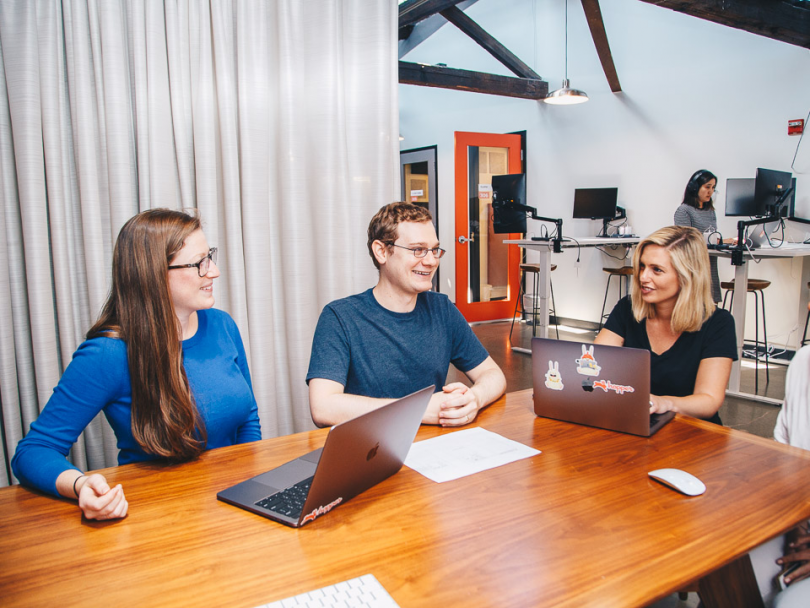It’s no secret that tech recruiters face stiff competition for talent, but the fight for data scientists is arguably the toughest. So much so that we've seen a 344% increase in demand for data scientists since 2013 and as of 2018, there was still a shortage of 150,000+ qualified candidates in the United States alone. And when you’re paying well over $100k in salary, you need to make sure you hired the best candidate for the role.
To help you track down these niche professionals and hire the best of the best, we’ve created this guide on the attributes data scientists care most about when pursuing career opportunities. We’ve also included tips on how and where to source people with this specific skillset.
Table of Contents
- Attribute 1: Opportunities to tackle new challenges
- Attribute 2: Experienced colleagues to learn from
- Attribute 3: A cohesive tech stack to work with
- Attribute 4: A close-knit company culture
See how your employer brand is performing in AI tools like ChatGPT and Google.
Attribute 1: Opportunities to tackle new challenges
When it comes down to it, most data science roles are doing the same basic tasks, so to attract top candidates, you need to offer competitive career advancement opportunities and make them known early in the recruitment process.
Why? 42% of millennials indicate that learning and development opportunities are the top factor they consider when accepting a job offer. And for employees who are dissatisfied with their current workplace, more than 40% leave their company because they don’t have a clear and actionable career path in place. To better understand what it is data scientists want to learn in their career, we gathered a list from Business Over Broadway of the top tools, technologies and languages data scientists are most excited to learn:
- TensorFlow (24%)
- Python (16%)
- R (8%)
- Spark/MLib (7%)
- Hadoop/Hive/Pig (4%)
- Amazon Machine Learning (4%)
- Jupyter notebooks (3%)
- Google Cloud Compute (3%)
If your tech team utilizes any of these technologies or is willing to either train employees or offer stipends for candidates to educate themselves outside of work, highlight this information everywhere you source candidates. If candidates know you’re ahead of the evolving tech learning curve, you’ll distinguish your company as an industry leader and will attract candidates eager to stay ahead of the competition. Here are a few ways we helped companies connect with candidates over their training and development opportunities.

We asked Darin Brannan, CEO of ClearDATA:
What role do you envision ClearDATA playing in the healthcare industry in the future?
"In one year, we want to be known as a thought leader in our market and a safe, smart way for healthcare organizations to transition to a public cloud IT delivery model that is ultra-secure and compliant. This will give healthcare providers greater access to, and use of, data to improve patient outcomes. We plan to continue modernizing and protecting healthcare data, but also reinventing additional healthcare technologies."
Learn more about how ClearData’s team continues to modernize its data.

We asked Vivek Vaid, CTO of FOURKITES:
Certainly, everyone in logistics is using data these days, but how is FourKites using it in ways that other companies aren’t?
"The big difference at FourKites is that we aren’t just using data to run a business — that data is our business. It might not sound significant, but it completely changes how you think about the types of people you hire, the leadership structure, the operations model, the focus on data quality and the overall level of data awareness across the organization. Priya Rajagopalan, our chief product officer, and Nick Bonfitto, our director of product support, know as much about our data structures as our data architects. Now that is a data company!
"As we help companies draw connections across their supply chains, our entire network derives from the insights of the pooled data. Those compounding effects — driven by the largest network of shippers, carriers and 3PLs in the industry — are where we have capabilities our competitors just cannot match."
Learn more about how FOURKITES’ team works together to learn and grow.
Attribute 2: Experienced colleagues to learn from
In addition to learning new technologies and working on exciting projects, one of the best ways for data scientists to advance in their career is to work with people who are exceptionally skilled in their field. It’s also a smart recruitment strategy to hire people who are eager to work on a team where they are not the smartest, most skilled person. These people will have the greatest impact on your team and company because they care more about continuously learning than they do about being #1.
Don’t be shy when connecting with prospective employees. Brag about your incredible team with employee spotlights and share all the amazing accomplishments they’ve achieved. Don't focus strictly on work accomplishments; if employees have projects outside of work they’re comfortable sharing, include that as a spotlight. Doing so will shine light on the unique personalities and interests on your team, making it easier for candidates to meaningfully connect with your team during the interview process.
Also, in any tech-heavy role, it’s important to stay ahead of the trends and keep up with the latest technology. Leverage your team’s knowledge and expertise and ask them how they intend to establish your company as an industry leader now and for years to come. Ask them how they keep up with trends and why, as experts in their field, they choose to stay at your specific company, when they have a world of job opportunities out there. Check out how we highlighted these experts and the opportunities they have to offer prospective candidates.

We asked Aihui Ong, SVP of Data and Insights at SNACKNATION:
How would you describe your leadership style?
"I like to be transparent with no BS. In a startup, we’re moving at a gazillion miles per hour and as a result, it’s easy to overload one’s responsibility. I regularly sit down with the team and help them divide their responsibilities into bitesize chunks so that no one feels overwhelmed. Once I set those clear goals, I have high expectations."
Learn more about SNACKNATION’s leadership team.

We asked Carl Anderson, Director of Data Science at WW:
You’ve had a really interesting career. Talk about your work experience leading into your current role and how that’s informed your work at WW.
"I’ve found that my breadth of experience working across different domains — for example, healthcare, e-commerce, data compression — helps me bring a new perspective to my job at WW. I think my ability to jump into new domains, read, absorb and ask a lot of 'dumb' questions is actually one of my superpowers.
"I’m passionate about data strategy and helping organizations to extract value, impact and insights from their data. My research and experiments at other organizations have informed the principles and best practices we bring to all our data users at WW."
Learn more about the different career paths at WW.

We asked Chris Leone, Manager of Data Analytics at Blinker:
If you look at what your team has achieved so far, what are you proudest of?
"When I started back in May 2017, there was no data team and no structured databases, but there was still a very strong appetite for data. This meant engineers were running queries against the production database in order to view any sort of data or reporting. I started around the same time as our former data engineer, so we both had to hit the ground running to work on tool evaluations and then get them stood up to start surfacing data.
"We signed with Chartio, and, from that point, we’ve created more than 120 dashboards and automated reports, as well as had the ability to surface information and dig deep anywhere necessary. The work obviously doesn’t stop there, but I’m extremely proud of where we got in a short amount of time and even more excited about where we’re headed."
Learn more about Blinker’s accomplished data team.
Attribute 3: A cohesive tech stack to work with
Data scientists today aren’t just looking over numbers in spreadsheets. They work with sophisticated technology that requires years of training and experience to master. When data professionals apply to jobs, one of the first things they need to know is what technology the company utilizes to collect and analyze data.
This information helps data candidates determine if the role is right for them before applying. To understand the current state of tech stacks utilized by data scientists, we gathered a list of the most used tools, technologies and languages from Business Over Broadway’s survey:
-
Python (60%)
-
R (46%)
-
SQL (42%)
-
Jupyter notebooks (32%)
-
TensorFlow (22%)
-
Amazon Web Services (18%)
-
Unix shell/awk (18%)
-
Tableau (16%)
-
C/C++ (15%)
-
NoSQL (15%)
-
MATLAB/Octave (14%)
-
Java (14%)
-
Hadoop/Hive/Pig (14%)
-
Spark/MLib (13%)
-
Microsoft Excel Data Mining (11%)
You don’t have to be an expert on these technologies in order to write a job description or talk with candidates. You should, however, talk with the hiring manager and experts on your data team to determine which technologies your company currently uses and which ones are essential skills for candidates to have in this role.
Then, you can relay this information in your recruitment marketing efforts and during interviews to ensure you’re bringing in the best people for the role. Here’s how we helped a few companies attract top talent by promoting this information.

We asked Matt DiNardo, Data Scientist at Hopper:
What tools does the data science team currently use?
"Given the size of the datasets we work with, we use PySpark for large-scale distributed computing. When working with smaller datasets, we use Python with the pandas’ library. In terms of data visualization, we have a variety of tools we use depending on what we need — Tableau for daily reporting, Plotly for interactive graphs and some R here and there for exploratory analysis."
Learn more about Hopper’s data tech stack.

We asked Doris Ip, Engineering Manager at Cadre:
What tech stack does your team use?
"We use Python 3 with Django, React with Redux, PostgreSQL and Ansible on AWS. We started with a few microservices written in Node.js along with our Python stack, but we realized our architecture was too complicated and unnecessary for our needs. So we simplified and hardened our core Python Django application. This helps us focus on defining best practices and patterns for our backend application code."
Learn more about the tech Cadre's data team uses.
Attribute 4: A close-knit company culture
Company culture is one of the most important factors that contribute to a candidates' decision to accept a job offer. Not only is it an important factor when it comes to looking for new job opportunities, but it’s actually one of the driving factors for employees leaving their current workplace.
Data professionals are in high demand, which means they have a wealth of job opportunities to choose from. You can stand out as a top choice employer by leveraging your exceptional company culture with prospective candidates. Here's how we helped a few companies highlight their unique company cultures to attract and retain data science talent.

We asked Caitlin Hawkins, Data Science Manager at Sense360:
What systems does Sense360 have in place to ensure that employees are collaborating within their teams and with other teams across the company?
"We recently restructured our tech teams into three pods to increase collaboration across the engineering and data science teams. Each pod is focused on work that aligns with a key business priority, and employees in it are empowered to work together to solve the issues at hand.
"We do a handful of different things to ensure collaboration on the data team, but the most exciting is that each month we get together and spend an afternoon digging into our data together. There is a general agenda, but we leave it up to the team to decide how we spend that time."
Learn more about Sense360’s close-knit company culture.

We asked Gregory Zajac, Delivery Data Scientist at Celonis:
Now that you and the company are more established, how do you think about building and maintaining a strong culture?
"To me, building a great culture boils down to one simple rule: 'Do unto others as you would have them do unto you.' That means going that extra step for your colleagues and lending a helping hand to someone even if it goes outside of your job description — you’d be grateful if someone did the same for you.
"Of course, being able to enact this rule successfully is contingent on the most important aspect of building any kind of culture: your people. If they are the kind of individuals who will go the extra step and lend a helping hand, then your people are the ones who propagate the culture and spread it throughout your organization."
Learn more about the culture on Celonis’ data team.
As your team continues its search for top data candidates, continue to utilize this guide along with our other tech recruiter resources to get talented data scientists in the door before they're off the job market. Check out our data scientist job description and data analyst job description templates to improve your quality of applicants, as well.





